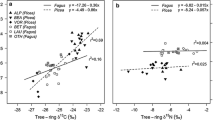Abstract
We describe an ontogenetic shift in nitrogen (N) isotopic values in two rosette-forming epiphytic bromeliads. Leaf tissue N isotope values of small individuals of two bromeliad species (mean −6.2‰) differed from those of large individuals within each species (mean −0.5‰). Using references for potential N sources, we calculated the relative contribution of autochthonous (soil-derived through leaf litter) and allochthonous (atmospheric deposition) N with a two-member mixing model. Atmospheric sources contributed as much as 77–80% of the N in small individuals, whereas soil-derived N contributed 64–72% (conservative reference value) to 100% (less conservative reference value) of leaf tissue N in large plants. Shifts in N source with increasing plant size may be important aspects of rainforest complexity, an understudied aspect of ecosystem diversity.

Similar content being viewed by others
References
Alpkem (1986) RFA methodology. Alpkem Corporation, Clackamas, Ore.
Bentley BL, Carpenter EJ (1984) Direct transfer of newly-fixed nitrogen from free-living epiphyllous microorganisms to their host plant. Oecologia 63:52–56
Benzing D (1986) In: Juniper B, Southwood T (eds) Insects and the plant surface. Arnold, London, pp235–256
Benzing D (2000) Bromeliaceae. Cambridge University Press, Cambridge
Ehleringer J, Rundel PW (1988) Stable isotopes: history, units, and instrumentation. In: Rundel PW, Ehleringer J, Nagy K (eds) Stable isotopes in ecological research, vol 68. Springer, Berlin Heidelberg New York, pp1–15
Eklund TJ, McDowell WH, Pringle CM (1997) Seasonal variation of tropical precipitation chemistry: La Selva, Costa Rica. Atmos Environ 31:3903–3910
Evans RD (2001) Physiological mechanisms influencing plant nitrogen isotope composition. Trends Plant Sci 6:121–126
Ewel JJ, Bigelow S (1996) Plant life-forms and tropical ecosystem functioning. In: Orians G, Dirzo R, Cushman J (eds) Biodiversity and ecosystem processes in tropical forests. Springer, Berlin Heidelberg New York, pp101–126
Guehl JM, Domenach AM, Bereau M, Barigah TS; Casabianca H, Ferhi A, Garbaye J (1998) Functional diversity in an Amazonian rainforest of French Guyana: a dual isotope approach (delta N-15 and delta C-13). Oecologia 116:316–330
Haggar JP, Ewel JJ (1997) Primary productivity and resource partitioning in model tropical ecosystems. Ecology 78:1211–1221
Heaton THE (1986) Isotopic studies of nitrogen pollution in the hydrosphere and atmosphere: a review. Chem Geol Isot Geosci Sect 59:87–102
Hietz P, Wanek W, Wania R, Nadkarni NM (2002) Nitrogen-15 natural abundance in a montane cloud forest canopy as an indicator of nitrogen cycling and epiphyte nutrition. Oecologia 131:350–355
Hiremath AJ (1999) Nutrient use efficiency in simplified tropical ecosystems. University of Forida, Gainesville, Fla.
Hiremath AJ, Ewel JJ (2001) Ecosystem nutrient use efficiency, productivity, and nutrient accrual in model tropical communities. Ecosystems 4:669–682
Holdridge LR (1967) Life zone ecology. Tropical Science Center, San Jose, Costa Rica
Maple M (2002) Maternal effects on offspring fitness in Dendrobates pumilio, the strawberry poison frog. University of Kentucky, Lexington
Nadelhoffer K, Fry B (1988) Controls on nitrogen-15 and carbon-13 abundances in forest soil organic matter. Soil Sci Soc Am J 52:1633–1640
Nadkarni NM, Primack RB (1989) The use of gamma spectrometry to measure within-plant nutrient allocation of a tank bromeliad, Guzmania lingulata. Selbyana 11:22–25
Richardson BA (1999) The bromeliad microcosm and the assessment of faunal diversity in a Neotropical forest. Biotropica 31:321–336
Robinson D (2001) delta-15N as an integrator of the nitrogen cycle. Trends Ecol Evol 16:153–162
Stewart GR, Schmidt S, Handley LL, Turnbull MH, Erskine PD, Joly CA (1995) N-15 natural-abundance of vascular rain-forest epiphytes—implications for nitrogen-source and acquisition. Plant Cell Environ 18:85–90
Wania R, Hietz P, Wanek W (2002) Natural N-15 abundance of epiphytes depends on the position within the forest canopy: source signals and isotope fractionation. Plant Cell Environ 25:581–589
Acknowledgements
We thank R. Chazdon, D. A. Clark, D. B. Clark, B. Fry, and J. Marshall for comments on previous versions of the manuscript; S. Mambelli, P. Brooks, and J. Cox for technical assistance. Sample analysis was done at the Center for Stable Isotope Biogeochemistry (University of California, Berkeley) and the Stable Isotope Laboratory (University of Arkansas, Fayetteville). Funding for this project came from NSF award DEB 9975235 and the Andrew W. Mellon Foundation.
Author information
Authors and Affiliations
Corresponding author
Rights and permissions
About this article
Cite this article
Reich, A., Ewel, J.J., Nadkarni, N.M. et al. Nitrogen isotope ratios shift with plant size in tropical bromeliads. Oecologia 137, 587–590 (2003). https://doi.org/10.1007/s00442-003-1386-1
Received:
Accepted:
Published:
Issue Date:
DOI: https://doi.org/10.1007/s00442-003-1386-1




